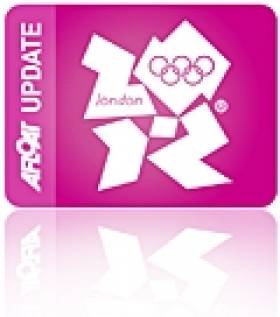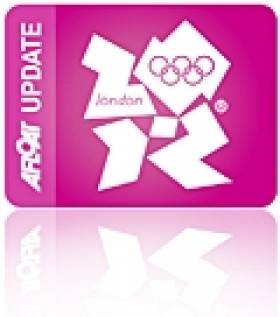Displaying items by tag: olympics 2012
Gap Closes Betwen 49er Crews
After six races at the Delta Lloyd regatta, both Irish 49er crews have posted a top ten result and the gap between them has narrowed. Ryan Seaton and Matt McGovern still lead Ger Owens and Ross Killian, with the newcomers in 40th and the northern crew in 36th place.
Light airs were the order of the day yesterday, however 17 knots are forecast for today which should test the crews further.
In the Laser Radials, Annalise Murphy posted a second in race five to move into 14th overall, with Tiffany Brien recording a DNF in the light airs, putting an end to a string of consistent finishes. She now lies in 17th.
Barry McCartin and Thomas Chaix are struggling to make an impact in the highly competitive 470 fleet, currently the last boat in the fleet to have completed all races to date.
Racing continues today.
Irish Underway at Delta Lloyd Regatta
Annalise Murphy of the National Yacht Club is the top Irish performer at the Delta Lloyd regatta after day one, placed 13tilh of 37 in the Laser Radial fleet, with three races sailed.
Meanwhile, the gap has closed slightly between Ireland's two 49er teams. Ger Owens and Ross Killian, in just their second campaign event, lie nine points and places behind Ryan Seaton and Matt McGovern, still vey much in charge of the Irish top slot in 28th position.
Finn sailor Ross Hamilton is 51st of 61, and Barry McCartin and Thomas Chaix are 76th of 81 in the 470 class.
Shifty but increasing wind has provided for tactical racing during the opening day of the 2010 Delta Lloyd Regatta in Medemblik, 5th event in the Sailing Word cup.The first half of the Opening Round robin has been completed with 4 matches sailed by the 24 crews in the Women match racing. The teams of MacGregor (GBR), Roca (ESP), Skudina (RUS) and Groeneveld (NED) succeeded in winning all their matches.
After four races in the 49er, the young British team of Dave Evans and Ed Powis is leading the fleet.
After two races, ISAF Sailing World Cup leaders, Eivind Melleby and Petter Morland Pedersen (NOR) are leading the Star fleet. After winning the Rolex Miami OCR and Hyeres week, the Norwegian have set their objective this year in winning the new Olympic classes circuit. With 16 boats in the Dutch event, the level is higher and racing today proved challenging.
After a long break, Mateusz Kusznierewicz and Dominik Zycki (POL) are back in the international circuit:
'We like to come and race in the Delta Lloyd Regatta in Medemblik. This year we have decided to take it easy and sail only three events. This is the first one this year and we are still a bit rusty. We have made some small changes to our boat and need to test them before the Star European Championship early June."
The Polish are second overall after taking the first race and placing 5th in the second.
Nic Hasher and Elliott Willis (GBR) are leading the 470 men with consistent results (1-2-4) over German team of Wagner/Scheufler.
The two Laser groups were last to finish. Trofeo Princesa Sofia Mapfre winner, Javier Hernandez is leading the fleet from Australian Tom Slingsby and Mattias del Solar (CHI).
2009 RS:X Vice World Champion, Nimrod Mashiah (ISR) enjoyed today's conditions with a five points score after three races sailed in the two RS:X groups. He is two points ahead of Alexandre Guyader (FRA) and current World Champion, Nick Dempsey (GBR). The Spanish Bianca Manchon is leading the RS:X women .
Sailing will resume on Thursday with the last chance for classes racing in groups to qualify for the Gold fleet. The Women Match racers will finish the opening round robin.
Unfortunately, the wind which had been increasing all evening will be very light on Thursday.
Delta Lloyd Kicks off on Wednesday
Thirty Olympic medallists are ready for the Delta Lloyd Regatta 2010 which runs from Wednesday until on Sunday May 30th. The 2010 edition has set record high pre-entries in all classes including the 2.4, with a total of 707 boats from 53 countries. As usual, the largest fleets are in the Laser, RS:X men and 470 men. Ireland has seven crews racing in the event.
`We have two years to go until the 2012 Olympic Games. All campaigns are at full strength, which makes it an interesting and strong competition. We look forward to welcoming the top international sailors to Medemblik`, says Arjen Rahusen, Chairman of the Delta Lloyd Regatta.The Dutch team will be present in all classes with many chances for medals. Dorian Van Rijsselberge (RS:X) and Thierry Schmitter (2.4) will defend their titles at home. Marit Bouwmeester who is leading the standings after a victory in Melbourne will try to add another SWC title. She will face 2009 winner Tatiana Drozdovskaya (BLR) or 2010 Palma winner Tina Mihelic (CRO), among a talented field in the laser radial.
2009 Champions will be back to defend their title in ten out of the eleven Olympic and Paralympic classes competing in the Delta Lloyd Regatta, with the exception of the Star class.
Blanca Manchon (ESP) in the RS:X and Ed Wright in the Finns will also aim to retain their 2009 World Cup title.
Paul Goodison (GBR) will start the event as hot favourite in the Laser class. The 2008 Gold medallist and world N.1 has just claimed victory in the Semaine Olympique Française in Hyères.
Pierre Leboucher and Vincent Garros won the 3rd SWC event in Palma de Mallorca during the Trofeo Princesa Sofia Mapfre and will be keen to prove themselves again in a strong 470 fleet. In the women division, World N.2 Ai Kondo and Wakato Tabata (JPN) are back to fight for their title. Main opponents include last year runner up Emmanuelle Rol and Hélène de France. The french pair claimed victory in Hyères and lead the Sailing World Cup standings.
In the 49er, double World Champions, Australian’s Nathan Outteridge and Iain Jensen are making their come back to the European circuit for the Delta Lloyd Regatta. They are aiming to defend their title. The Sibello brothers (ITA), in good shape after their recent win in Garda, want to prove why they are leading the World ranking.
The British trio of Lucy MacGregor, Annie Lush and Ally Martin will face 23 teams in the Women Match racing division sailed for the first time in Medemblik on the new Elliott boats.
The only Champions absents among last year’s winners will be Brazilians Robert Scheidt and Bruno Prada in the Star class. After winning both the Rolex Miami OCR and the Semaine Olympique Française in Hyères, the Norwegians Eivind Melleby and Petter Moer are the favourite for the Delta Lloyd Regatta title as well as the 2010 Sailing World Cup.
The Delta Lloyd Regatta will mark the come back to international competition this year for Pieter-Jan Postma (NED) in the Finn class, for Polish duo Matesz Kusznierewicz (2 Olympic medals) and Dominic Zycki in the Star or Double world Laser champion, Australian Tom Slingsby.
Roy Heiner returns to Finn sailing
After claiming a Finn bronze medal in Atlanta in 1996, Roy Heiner (NED) had turned to match racing, Soling and Ocean racing. A recent and successful comeback to the Finn scene during the Dutch Open championship last September has motivated Heiner for more! He will participate in this year Delta Lloyd regatta in the Finns, fourteen years after his medal and retirement from the Finn scene!
Entries Open for Skandia for Gold Regatta
-
Entries for the 2010 Skandia Sail for Gold Regatta are now open, to enter online or download the Notice of Race log onto the event website which is now live at www.skandiasailforgoldregatta.co.uk
The fifth installment of this international regatta takes place between 9th – 14th August at the Weymouth and Portland National Sailing Academy in Dorset. In 2009 the Skandia Sail for Gold Regatta welcomed a record entry of over 600 sailors, the 2010 event is expected exceed this when it will host more than 750 sailors across 10 Olympic and 3 Paralympic classes.
Skandia remains onboard as title sponsor for the event. The Southampton-based long term investment company, which is well known for its support of sailing, has been title sponsor since the event’s inception in 2006. Alongside Skandia, UK Sport has announced their continued involvement as an event partner. This forms part of UK Sport’s World Class Events Programme, which distributes approximately £4 million of Lottery funding each year to support the bidding and staging costs of major events on home soil, as well as providing specialist support to organisers.
Esther Nicholls, Events Consultant for UK Sport, said: “UK Sport is committed to bringing world class sporting events to the UK ahead of 2012, in what we believe will be the most comprehensive pre-Games events programme ever staged by an Olympic host nation. Skandia Sail for Gold 2009 provided not only another invaluable opportunity for British sailors to compete at home, but also a step change in how spectators were able to engage with the event. UK Sport is delighted to be supporting Skandia Sail for Gold for the fifth consecutive year, and we look forward to seeing our athletes gain further knowledge of competing, and hopefully winning, on home waters ahead of 2012, as well as the continued evolution of the spectator experience.”
The Skandia Sail for Gold regatta is one of the biggest events on the 2010 sailing calendar, not only will it give competitors an opportunity to compete on Olympic and Paralympic waters ahead of 2012, but it will also play host to the seventh and final instalment of the 2009/10 edition of the ISAF Sailing World Cup series. Great Britain currently tops the rankings and will be looking to secure the overall title in Weymouth.
Utilising the power of the internet, the event will showcase online technology delivering sailing to a global audience through tracking, live interactive blogs and live radio. The event will be open to the general public who can come down each day to follow the racing onshore, there will be a giant screen broadcasting video and tracking, alongside live commentary.
“This is a crucial event on the calendar, it provides a unique opportunity for teams to compete at the state-of-the-art London 2012 Olympic and Paralympic sailing venue. We intend to bring sailing to the masses through the use of the latest technology and are working alongside Trac Trac and Be Tomorrow to deliver the very best user experience we can for the remote online audience. We will be revealing more extensive details of the tracking capabilities at the event soon,” commented Event Director David Campbell James.
SCHEDULE OF EVENTS
Friday 6th August Event Office opens for registration
Sunday 7th August Briefing for coaches and team leaders
Monday 9th August Racing day 1
Tuesday 10th August Racing day 2
Wednesday 11th August Racing day 3
Thursday 12th August Racing day 4
Friday 13th August Racing day 5
Saturday 14th August Medal Races (no warning signal after 1530)
For the latest news, to enter online and for media accreditation go to: www.skandiasailforgoldregatta.co.uk
































































